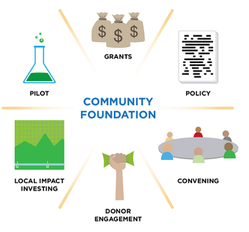Foundations use many tools to spur community wealth building. Grant-based initiatives are one prominent strategy. Here, however, we focus on program-related investments. Program-related investments, also known as PRIs, leverage limited foundation dollars—most often by providing long-term, low-interest loans—to promote community wealth building and other mission-related foundation goals.
The use of PRIs has been traced back to the 18th century when Benjamin Franklin, considered America’s first social investor, used instruments such as revolving loan funds to support a range of charitable organizations. The Ford Foundation, one of the first to use PRIs, began its program in 1968. According to a 1974 review of its first five years, even after accounting for loan losses, administrative costs, and the opportunity cost inherent in providing money at a below-market rate of interest, Ford found that “$1 million invested in a PRI is the equivalent of $5 million in grant expenditures.” Since then, the use of PRIs has grown steadily. In 2006-2007, the top five PRI providers were the ALSAM Foundation, followed by the Ford Foundation, the John D. and Catherine T. MacArthur Foundation, the David & Lucile Packard Foundation, and the Bill & Melinda Gates Foundation.
A survey conducted by The Foundation Center found that foundations provided a total of over $387.6 million in program-related investments in 2007. Although modest (the amount was slightly under 1% of the amount of grants disbursed), these PRIs leverage over $1 billion a year, a considerable sum.
Their importance is even greater than their numbers, as PRIs are a leading practical example of a growing trend of "double bottom-line" investing (i.e., investing that seeks a blended financial and social return). According to a 2002 study conducted on behalf of the Rockefeller Foundation, as much of 75% of actual “double bottom-line” investing in the United States can be said to take the form of PRIs.
At present, most foundations allocate just over the legally mandated 5% minimum of assets to mission-related activity. Many are now calling on foundations to place some of the 95% of their remaining assets in "double bottom-line" investing. The Heron Foundation has been a leader in this area, investing 20% of its assets in grants, PRIs, and other forms of social investment as of July 2005.
The effects of PRIs on community wealth building have been substantial, helping support the growth to scale of community development corporations (CDCs) and community development financial institutions (CDFIs). The long-term, low-interest financing that PRIs provide has enabled CDCs and CDFIs to leverage significantly greater private funding. To take one prominent example, the Living Cities program (which has supported over 200 CDCs in 23 cities over the past decade) used roughly $150 million in foundation PRIs and corporate support in the early 1990s to leverage $750 million in community development investment.
Key Facts and Figures
U.S. foundations total PRIs (2009 vs. 1990): $701 million vs. $139 million
Average PRI loan size (2009 vs. 1990): $1.5 million vs. $666,000
Number of foundations providing PRIs: 64
